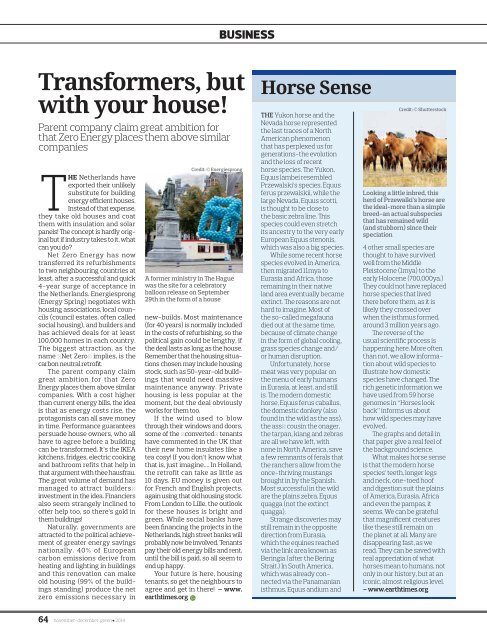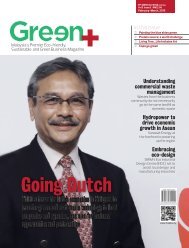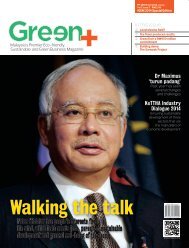Green+ Malaysia's Premier Eco-friendly, Sustainable and Green Business Magazine
SIRIM - Technology Provider
SIRIM - Technology Provider
Create successful ePaper yourself
Turn your PDF publications into a flip-book with our unique Google optimized e-Paper software.
BUSINESS<br />
Transformers, but<br />
with your house!<br />
Parent company claim great ambition for<br />
that Zero Energy places them above similar<br />
companies<br />
The Netherl<strong>and</strong>s have<br />
exported their unlikely<br />
substitute for building<br />
energy efficient houses.<br />
Instead of that expense,<br />
they take old houses <strong>and</strong> coat<br />
them with insulation <strong>and</strong> solar<br />
panels! The concept is hardly original<br />
but if industry takes to it, what<br />
can you do?<br />
Net Zero Energy has now<br />
transferred its refurbishments<br />
to two neighbouring countries at<br />
least, after a successful <strong>and</strong> quick<br />
4-year surge of acceptance in<br />
the Netherl<strong>and</strong>s. Energiesprong<br />
(Energy Spring) negotiates with<br />
housing associations, local councils<br />
(council estates, often called<br />
social housing), <strong>and</strong> builders <strong>and</strong><br />
has achieved deals for at least<br />
100,000 homes in each country.<br />
The biggest attraction, as the<br />
name Net Zero implies, is the<br />
carbon neutral retrofit.<br />
The parent company claim<br />
great ambition for that Zero<br />
Energy places them above similar<br />
companies. With a cost higher<br />
than current energy bills, the idea<br />
is that as energy costs rise, the<br />
protagonists can all save money<br />
in time. Performance guarantees<br />
persuade house owners, who all<br />
have to agree before a building<br />
can be transformed. It’s the IKEA<br />
kitchens, fridges, electric cooking<br />
<strong>and</strong> bathroom refits that help in<br />
that argument with thee hausfrau.<br />
The great volume of dem<strong>and</strong> has<br />
managed to attract builders<br />
investment in the idea. Financiers<br />
also seem strangely inclined to<br />
offer help too, so there’s gold in<br />
them buildings!<br />
Naturally, governments are<br />
attracted to the political achievement<br />
of greater energy savings<br />
nationally. 40% of European<br />
carbon emissions derive from<br />
heating <strong>and</strong> lighting in buildings<br />
<strong>and</strong> this renovation can make<br />
old housing (99% of the buildings<br />
st<strong>and</strong>ing) produce the net<br />
zero emissions necessary in<br />
Credit: © Energiesprong<br />
A former ministry in The Hague<br />
was the site for a celebratory<br />
balloon release on September<br />
29th in the form of a house<br />
new-builds. Most maintenance<br />
(for 40 years) is normally included<br />
in the costs of refurbishing, so the<br />
political gain could be lengthy, if<br />
the deal lasts as long as the house.<br />
Remember that the housing situations<br />
chosen may include housing<br />
stock, such as 50-year-old buildings<br />
that would need massive<br />
maintenance anyway. Private<br />
housing is less popular at the<br />
moment, but the deal obviously<br />
works for them too.<br />
If the wind used to blow<br />
through their windows <strong>and</strong> doors,<br />
some of the converted tenants<br />
have commented in the UK that<br />
their new home insulates like a<br />
tea cosy! If you don’t know what<br />
that is, just imagine…. In Holl<strong>and</strong>,<br />
the retrofit can take as little as<br />
10 days. EU money is given out<br />
for French <strong>and</strong> English projects,<br />
again using that old housing stock.<br />
From London to Lille, the outlook<br />
for these houses is bright <strong>and</strong><br />
green. While social banks have<br />
been financing the projects in the<br />
Netherl<strong>and</strong>s, high street banks will<br />
probably now be involved. Tenants<br />
pay their old energy bills <strong>and</strong> rent,<br />
until the bill is paid, so all seem to<br />
end up happy.<br />
Your future is here, housing<br />
tenants, so get the neighbours to<br />
agree <strong>and</strong> get in there! – www.<br />
earthtimes.org<br />
Horse Sense<br />
The Yukon horse <strong>and</strong> the<br />
Nevada horse represented<br />
the last traces of a North<br />
American phenomenon<br />
that has perplexed us for<br />
generations-the evolution<br />
<strong>and</strong> the loss of recent<br />
horse species. The Yukon,<br />
Equus lambei resembled<br />
Przewalski’s species, Equus<br />
ferus przewalskii, while the<br />
large Nevada, Equus scotti,<br />
is thought to be close to<br />
the basic zebra line. This<br />
species could even stretch<br />
its ancestry to the very early<br />
European Equus stenonis,<br />
which was also a big species.<br />
While some recent horse<br />
species evolved in America,<br />
then migrated 11mya to<br />
Eurasia <strong>and</strong> Africa, those<br />
remaining in their native<br />
l<strong>and</strong> area eventually became<br />
extinct. The reasons are not<br />
hard to imagine. Most of<br />
the so-called megafauna<br />
died out at the same time,<br />
because of climate change<br />
in the form of global cooling,<br />
grass species change <strong>and</strong>/<br />
or human disruption.<br />
Unfortunately, horse<br />
meat was very popular on<br />
the menu of early humans<br />
in Eurasia, at least, <strong>and</strong> still<br />
is. The modern domestic<br />
horse, Equus ferus caballus,<br />
the domestic donkey (also<br />
found in the wild as the ass),<br />
the ass cousin the onager,<br />
the tarpan, kiang <strong>and</strong> zebras<br />
are all we have left, with<br />
none in North America, save<br />
a few remnants of ferals that<br />
the ranchers allow from the<br />
once-thriving mustangs<br />
brought in by the Spanish.<br />
Most successful in the wild<br />
are the plains zebra, Equus<br />
quagga (not the extinct<br />
quagga).<br />
Strange discoveries may<br />
still remain in the opposite<br />
direction from Eurasia,<br />
which the equines reached<br />
via the link area known as<br />
Beringia (after the Bering<br />
Strait.) In South America,<br />
which was already connected<br />
via the Panamanian<br />
isthmus, Equus <strong>and</strong>ium <strong>and</strong><br />
Credit: © Shutterstock<br />
Looking a little inbred, this<br />
herd of Przewalki’s horse are<br />
the ideal-more than a simple<br />
breed-an actual subspecies<br />
that has remained wild<br />
(<strong>and</strong> stubborn) since their<br />
speciation<br />
4 other small species are<br />
thought to have survived<br />
well from the Middle<br />
Pleistocene (1mya) to the<br />
early Holocene (700,000ya.)<br />
They could not have replaced<br />
horse species that lived<br />
there before them, as it is<br />
likely they crossed over<br />
when the isthmus formed,<br />
around 3 million years ago.<br />
The reverse of the<br />
usual scientific process is<br />
happening here. More often<br />
than not, we allow information<br />
about wild species to<br />
illustrate how domestic<br />
species have changed. The<br />
rich genetic information we<br />
have used from 59 horse<br />
genomes in “Horses look<br />
back” informs us about<br />
how wild species may have<br />
evolved.<br />
The graphs <strong>and</strong> detail in<br />
that paper give a real feel of<br />
the background science.<br />
What makes horse sense<br />
is that the modern horse<br />
species’ teeth, longer legs<br />
<strong>and</strong> neck, one-toed hoof<br />
<strong>and</strong> digestion suit the plains<br />
of America, Eurasia, Africa<br />
<strong>and</strong> even the pampas, it<br />
seems. We can be grateful<br />
that magnificent creatures<br />
like these still remain on<br />
the planet at all. Many are<br />
disappearing fast, as we<br />
read. They can be saved with<br />
real appreciation of what<br />
horses mean to humans, not<br />
only in our history, but at an<br />
iconic, almost religious level.<br />
– www.earthtimes.org<br />
64<br />
november-december, green+.2014





